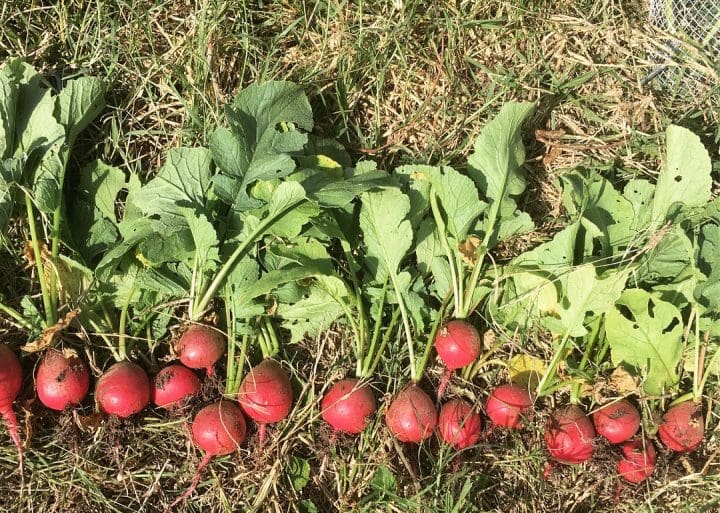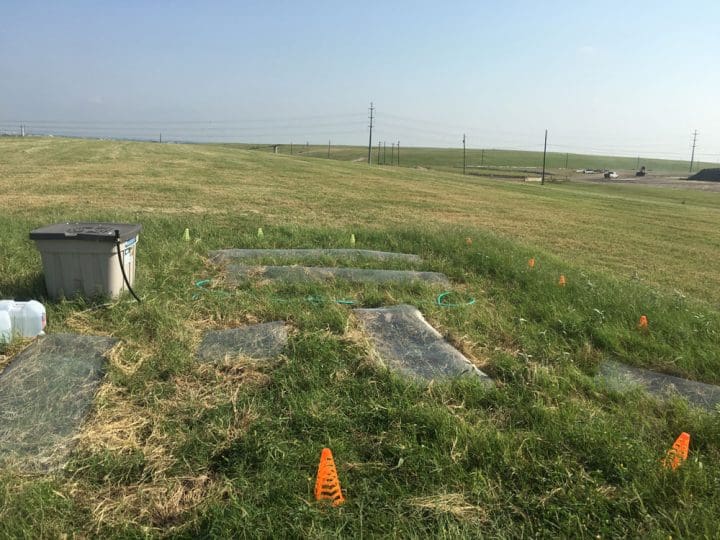Joy Youwakim wants us to eat more junk food. But she’s not talking about McDonald’s. Because this economics student from Texas has been growing vegetables on a disused landfill site. Here, she tells The Canary what this could mean for her community and the world.
Food deserts
Youwakim is concerned about so-called “food deserts” in the US. “We have Walmart and other grocery chains, but they will only open… if they know they’re going to make a profit,” she says. This creates food deserts: low-income areas where there are no grocery stores. People in those areas often rely on getting their groceries from the nearest gas station. Youwakim says:
Most of the time there is no produce. Or if there is, it’s just an apple or a banana or two. And the big… gas stations have more but those don’t tend to be in small communities. So you have a lot of kids growing up on processed food, who haven’t seen many vegetables in their lives.
But ‘food deserts’ also applies to areas where people don’t have access to groceries within a mile of home:
In the US, you have a lot of people driving an hour and a half to get to a Walmart. And that’s time when you aren’t making money; you’re spending gas. And you have perishable foods on an hour-and-a-half car ride, so they deteriorate.
The answer is… junk food?
Youwakim started researching how to grow sustainable food from an economics perspective. Her tutor, Bill Wolesensky:
used to be a corn farmer in Nebraska. So we grew corn and sorghum to test their drought resistance – in his back yard!
This paved the way for her next venture: growing produce on landfill. Youwakim worked at the Texas Commission on Environmental Quality during her summer break:
I met someone whose job was to regulate landfill. He showed me a picture of a landfill site. It was just a big hill.” Disused landfill sites, she explains, are covered with a thick membrane of clay or fibreglass, and then about 18 inches of soil is put over that. I said ‘is anyone growing food on those?’ He said ‘no way – we would never allow that.’ So I spent the next 13 months of my life trying to get permission.
Youwakim began writing “some very aggressive emails” to get permission to grow produce on a publicly owned landfill site in Del Valle, Austin. Eventually, in 2017, she gained permission to start growing produce on the site.
Digging for victory
Youwakim got to work growing cucumbers, radishes, cantaloupes and onions on the landfill plot. “They gave us six months and they were very keen to have us off. They didn’t want the liability. So we grew the food, tested it and got out,” she says.

Apart from having to lug water to the site, the actual process was pretty straightforward.
Everything grew really quickly – we were surprised by that. But anything we grew had to have shallow roots”, she explains. This was to prevent roots reaching down through the membrane layer beneath the soil, which could cause expensive damage. Also, “we had a company who offered to test our food for free. That saved us thousands of dollars.”
So how safe is landfill food?
Unsurprisingly, Youwakim’s project has raised a few eyebrows. After all, surely growing food on top of toxic waste isn’t that safe?
We tested for the 10 most common heavy metals found in soil, and we tested for listeria and salmonella which are also common. We also tested them against vegetables from the local grocery store, and the values were pretty similar in both of them.
But Youwakim’s research may have shown up some holes in global food safety standards:
The only standards we do have about heavy metals come from the World Health Organisation… The produce we grew was basically in line with all of those regulations, but, I think, two or three of [the levels] were too high. But then, so was the produce from our local grocery store. So it’s either cause for concern or cause for re-evaluating the standards for every country.
There is actually surprisingly little data about food safety, Youwakim says:
We just don’t have the standards to accurately compare, which makes our research preliminary… We should be recording more and analysing more. Unfortunately… we don’t have much information about, for example, how much cadmium should be in a bell pepper. That’s just not known.
“Why would I eat food grown on trash?”
Despite comparing favourably in the food safety tests, Youwakim acknowledges that there is a stigma attached to growing food on landfill.
It’s tricky because we say we’re growing this food and we can’t eat it because we’re getting it tested. People who are supportive still say ‘why would I eat food that’s grown on trash when I can eat food that’s from elsewhere?’ And I say, ‘But do you know where that food was from either?’ And most of the time people don’t.
We think of food as coming in a box now. Nobody thinks about the very beginnings – the seeds, the farm-to-table aspect.
As well as food safety concerns, Youwakim faced some politically motivated criticism.
People said ‘you want to feed poor people trash food!’ But this is going to specifically help poor people. It has a low carbon footprint. And, you have landfills in areas that are food deserts… the landfill itself is lowering property values: nobody wants to live near a high pile of trash. But if we can change that, those property values go up. People who need food assistance can have [it] – and it’s good food that we’ve grown here. I think it’s important people look past [the stigma].
Money talks
It’s clear that Youwakim is the right balance of idealist and realist. She’s passionate about creating food security for millions of people who currently don’t have access to good produce. The US is the world’s largest economy, but 40 million people are food insecure and one in six American children lives in poverty. Youwakim has both US and Lebanese nationality and says this shapes her perspective. So she’s keen to find ways to help other countries deal with issues of hunger and poverty too.
But she realises that idealism will only get her so far. She says:
It’s important to talk about environmental issues from a quantitative perspective because at the end of the day the decisions are made with money. How much money will it cost? How much will we save? How much is it going to mitigate things for us in the future? People, investors, policy makers all talk in terms of dollars.
Getting the word out
Before long, Youwakim’s project began to garner interest, and in 2018 she was nominated for the General Mills Feeding Better Futures Scholars’ Program – a new award aimed at “solving the food accessibility problems of today and tomorrow with help and ideas from amazing young people”.
She says:
Prior to all the media attention, it was really just me and the landfill. And I definitely felt alone in that work, especially with all the pushback from our government. But when I had all this support from… people who were glad I was doing it, it felt worth it. I was really surprised. Being on the internet… was very exposing. But it got things started. And there’s strength in numbers.

The landscape of the future
Youwakim has now moved on to her master’s degree. No longer based in Austin, she’s now in the Rio Grande Valley on the Mexico border, which, she says, “is the Mecca of agriculture in Texas”.
We grow most of the food that feeds Texas here. We don’t have the same issue with the urban population needing farming space. So I’m not looking at landfill.
But, she continues:
I am looking at heavy metals in soil and how that affects food. Heavy metals cause a lot of cancer in later life. Post-NAFTA [The North American Free Trade Agreement] many companies moved their manufacturing… to the Mexico border. People dump a lot of stuff into the river, and this is the same river we use to irrigate our produce. So looking at how it infiltrates the soil… and how that affects our food, is what I’m doing my masters on. But with the research I’m providing, the students in Austin are at least trying to start a small garden. We got the ball rolling with our research. The bureaucracy is very slow but we’ve done our part.
We know the issues
Landfill is quite literally changing the shape of our landscapes. The UK is rapidly running out of landfill space and our throwaway habits have long since earned us the dubious title “ the dustbin of Europe”. Meanwhile, the US reportedly has 2,000 active landfills. But Youwakim says, “the EPA [Environmental Protection Agency] is not even allowed to record how many landfills we have… That makes you question your government and their intentions.”
Most recent UN figures show that one in nine people in the world are undernourished – around 815 million of us. And, as Youwakim highlights, very often if you’re poor, you don’t get to make good sustainable decisions about what food you buy and what packaging you throw away.
So, if we could use old landfills to grow food, how different would our landscapes become? Could this be an opportunity to grow cheap, nutritious food within communities, which wouldn’t need wrapping or transportation? How many allotment plots could be created for people who are currently experiencing real food insecurity? But currently, neither space nor knowledge is available to a lot of people:
It’s a privilege to have the time to grow your own food and also to live in an area where there’s space. Land is becoming a really scarce resource. To have the opportunity to experiment with it first is rare. I mean, you have college students who run microfarms or clubs and there are community gardens… but it’s not as accessible as it should be to grow your own food.
What we need is the will
The world needs pioneers like Youwakim. The ideas are there, and people like her are ready to lead the research and the hard work. What we need is the political will to look at hunger and food insecurity from a different angle. As Youwakim says:
When people see someone doing something unusual, instead of being supportive and saying ‘nobody’s thought about that before’, they want to say, ‘oh well, this is why we haven’t already done it’. And that’s not the attitude we need when we’re trying to change things.
Hunger is a huge issue… huge and complicated, which is why we still have it. This project won’t end hunger. But if we can do one small part in certain communities…
Even with the people you really respect and value you sometimes just have to stick to what you know – and that can be really hard. I was just really stubborn.
You need the right kind of attitude for those things to happen.
And with attitudes like Youwakim’s, maybe we can finally consign hunger to the trash.
Featured image and other images via Joy Youwakim
















